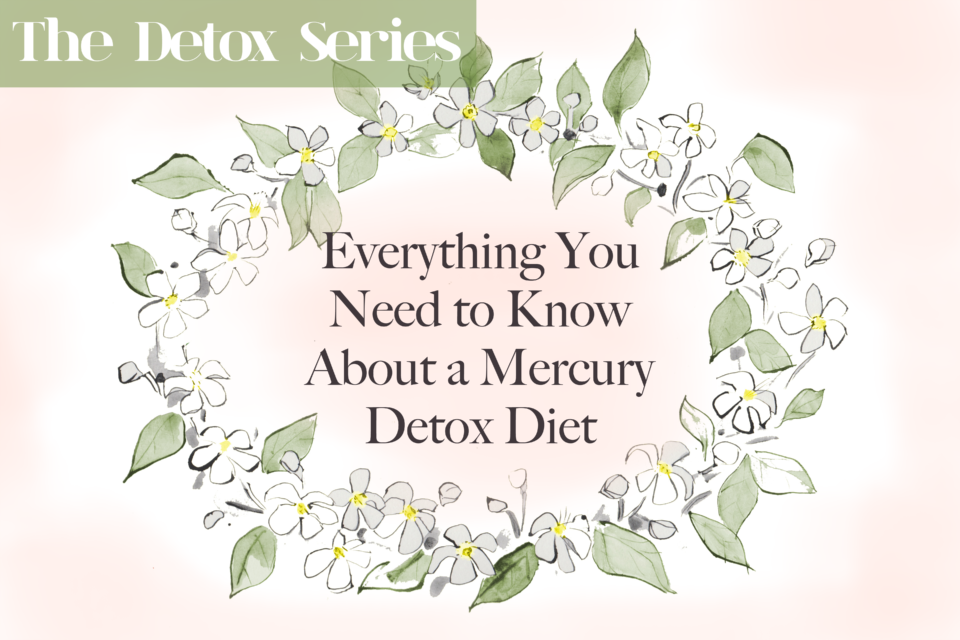Everything You Need to Know About a Mercury Detox Diet
Are you looking for diet recommendations to help detox mercury and other heavy metals from your body? You’ve come to the right place!
Heavy metal poisoning poses a serious threat to our health and well-being–and most of us aren’t even aware of it!
In this article, we will discuss the potential risks of heavy metal poisoning, as well as offer actionable suggestions for detoxing your body from one of the most dangerous heavy metals–mercury–right now.
What is Heavy Metal Poisoning?
Heavy metals, such as mercury, lead, and aluminum, accumulate in the body over time.
They can enter the body through the skin, or by inhalation or digestion.
Heavy metal poisoning occurs when excessive exposure to heavy metals affects the normal function of the body.
It can result from sudden, severe exposure, or from slow, chronic exposure over time.
The symptoms of heavy metal poisoning can vary depending on the metal involved and the amount absorbed, as well as the age of the person.
Nausea, vomiting, and diarrhea are common symptoms of heavy metal poisoning.
Keep in mind that excessive exposure and damage to internal organs may occur even if a person does not display any symptoms.
Mercury is one of the most dangerous heavy metals and, unfortunately, one of the most prevalent.
It is considered one of the top ten chemicals of major public health concern because it may have toxic effects on our nervous, digestive, and immune systems, as well as on our lungs, kidneys, skin, and eyes.
Unfortunately for us, mercury can be found almost everywhere-–including our air, water, and yes, even our food.
What is a Mercury Detox Diet?
Any type of heavy metal detox aims to remove heavy metals from your body and minimize their impact on your health.
A mercury detox diet focuses specifically on removing the negative effects of mercury poisoning through changes in diet.
Thankfully, a detoxifying diet regimen is also one of the least invasive ways to detox mercury from your body.
By eliminating toxic foods from your diet and adding foods that help detoxify the liver and cleanse the body, you may be able to reverse heavy metal poisoning without resorting to medical treatments such as chelation therapy.
Since there is some overlap in recommended foods and supplements, a mercury detox diet may be helpful for other types of heavy metal poisoning as well.
How to Do Your Own Mercury Detox Diet
Step 1: Eliminate toxic foods
Eliminate foods that are likely to contain excessive amounts of mercury from your diet.
While the Food and Drug Administration recommends eating at least 8 ounces of seafood per week, you should avoid fish with high mercury levels.
This includes:
- King mackerel
- Shark
- Swordfish
- Marlin
- Tilefish
- Tuna
- Orange roughy
In addition, avoid high fructose corn syrup–a substance used in many food products to enhance their shelf life.
It may contain significant amounts of mercury. This is especially important for children and more sensitive populations.
Step 2: Cleanse your body
Once you have eliminated mercury from your diet, it’s time to flush it out of your system.
Drink plenty of water and eat fresh, unprocessed foods during your detox.
If you want to take it a step further, you can try fasting for up to 3 days.
In addition to giving your body a clean slate to work with, it could help you mentally prepare for making lasting changes in your diet.
Step 3: Incorporate detoxifying foods
Incorporating detoxifying foods, such as cilantro, chlorella, and various herbs, into your diet, is a great way to speed up the detox process.
Cilantro has been found to displace heavy metals stored deeply inside our connective tissue.
Chlorella increases the elimination of mercury from the gastrointestinal tract, muscles, ligaments, connective tissue, and bone.
In addition, milk thistle (Silybum marianum), cloves (Eugenia aromatica), garlic (Allium sativum), and turmeric (Curcuma longa) contain antioxidant and anti-inflammatory properties which may be useful during the detox process.
Step 4: Nourish your body
The rest of your diet should support the normal functioning of the body and mind.
Getting the right amount of vitamins and minerals during your detox process is very important, especially if you include a fasting component in the beginning.
Eat plenty of healthy, nourishing foods and consult with your doctor about recommended supplements.
Step 5: Sweat it out
Supplement your mercury detox diet with regular exercise to sweat out the toxins and improve your body’s ability to remove them from your system.
If you have access to a sauna, hop in for a quick 20-minute sweat a few times a week.
Mercury Detox Diet Concerns
A mercury detox diet may make you feel worse before it makes you feel better.
You may experience uncomfortable detox symptoms during your first week of implementing a mercury detox protocol.
These symptoms will likely go away on their own after the first week of detoxing.
Final Thoughts
A mercury detox diet is one of the easiest and least invasive ways to remove mercury from your system.
Want to get the latest scoop on beauty and wellness trends?
Sign up for our newsletter below!
Research:
Genetic and Rare Diseases Information Center, “Heavy metal poisoning,” April 27, 2017.
World Health Organization, “Mercury and Health,” March 31, 2017.
U.S. Food & Drug Administration, “Advice about eating fish.”
Environmental Health: A Global Access Science Source, “Mercury from chlor-alkali plants: measured concentrations in food product sugar,” Jan 26, 2009
Daru: Journal of Faculty of Pharmacy, Tehran University of Medical Sciences, “Current approaches of the management of mercury poisoning: need of the hour,” June 2, 2014.







